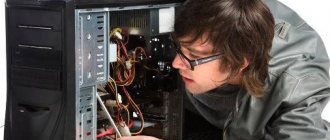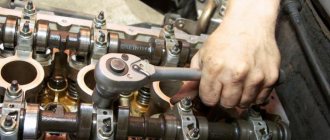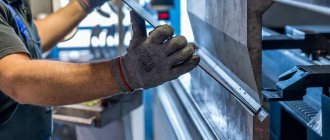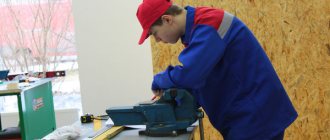Metal structures for various purposes are used everywhere. They are popular primarily because of their practicality and durability, as well as their comparative ease of manufacture.
There are now a great variety of professions that specialize in working with metal and steel: blacksmiths, grinders, stampers, foundry workers. However, special people are responsible for the appearance of the final product - assemblers and mechanics of metal structures. Such professionals are highly valued among employers, especially when it comes to assembling high-rise structures.
Responsibilities and specialization of a mechanic for assembling metal structures
A metal fabricator is a worker who shapes the finished product. Unlike a metal structure assembler, he knows how to modify parts directly at the assembly site, adjust them to each other, and smooth out irregularities. Welding work, where necessary, is also a mandatory operation. In other words, a metal fabricator turns blanks into finished parts and then helps assemble them into a single unit.
Such specialists are widely in demand at many different enterprises. They are indispensable in the assembly of cell towers, standard design structures, in the production of aircraft, trains and other vehicles. The most qualified work on the creation of space rockets and weapons systems.
His immediate responsibilities include:
- working with templates, marking parts using them;
- assembly of structures;
- creating holes for connecting parts;
- checking elements for defects and eliminating them;
- creating diagrams and sketches for working with parts.
The responsibilities of a mechanic with a higher level of qualifications also include administrative activities. In production, he can be responsible for the work of less experienced partners and lead a team. In this case, the mechanic also maintains technical documentation and checks the quality of the assembly.
To successfully cope with the job, a locksmith needs to know:
- purpose and skills of working with tools (machines, hand tools);
- use of auxiliary structures;
- process technology for assembling structures;
- quality standards for products;
- methods for identifying defects and checking serviceability;
- signal system adopted in production.
Working with metal is generally quite a dangerous business. Many cutting surfaces, metal shavings, moving machine parts. Minors and people without proper qualifications should not be allowed to do such work.
The work of a mechanic assembling metal structures is doubly dangerous if he has to work with large parts. He bears full responsibility for the tasks assigned to him and must monitor the serviceability of the tools and the quality of the products. Defects in such work always mean penalties and personal responsibility, because sometimes people’s lives depend on the quality of the workmanship.
JOB DESCRIPTION FOR FURNITURE ASSEMBLY
I APPROVED __________________________ (full name) General Director (institution, organization) __________________________ JOB DESCRIPTION for furniture assembler 1. GENERAL PROVISIONS 1.1. This job description defines the functional duties, rights and responsibilities of the Furniture Assembler. 1.2. A furniture assembler is appointed and dismissed in accordance with the procedure established by current labor legislation by order of the General Director. 1.3. The furniture assembler reports directly to ___________________________. 1.4. A person with _____________ (higher, secondary education) and work experience in the specialty ______ years is appointed to the position of Furniture Assembler. 1.5. The furniture assembler must know: technical conditions, types, methods of performing furniture assembly work, regulations, instructions, orders, other guidelines and regulatory documents relating to the work of a trade enterprise; rules and methods for organizing customer service; labor legislation; rights and obligations of employees and their work schedule; Internal labor regulations; labor protection rules and regulations; safety rules, industrial sanitation and hygiene, fire safety. 1.6. During the period of temporary absence of the Furniture Assembler, his duties are assigned to ___________________________. 2. FUNCTIONAL RESPONSIBILITIES 2.1. Furniture assembler: 2.1.1. Receives components from the warehouse for furniture assembly on the basis of an agreement concluded with the buyer. 2.1.2. Accompanying the delivery of furniture to the buyer. 2.1.3. Receives, if necessary, tools for furniture assembly from the warehouse. 2.1.4. Present when unloading furniture components to the buyer’s apartment (office). 2.1.5. Unpacks components. 2.1.6. Assembles components in accordance with manufacturer's requirements. 2.1.7. Installs built-in household appliances into pieces of furniture. 2.1.8. Complies with labor and production discipline, labor protection rules and regulations, industrial sanitation and hygiene requirements, fire safety requirements, and civil defense. 2.1.9. Executes orders and instructions from the enterprise administration. 2.1.10. Informs management about existing shortcomings in the operation of the enterprise and possible measures to eliminate them. 2.1.11. Has a neat appearance during the working day. 3. RIGHTS 3.1. The furniture assembler has the right: 3.1.1. Take appropriate actions to eliminate the causes that create obstacles to the performance of their functional duties. 3.1.2. Make proposals to the enterprise administration for improving work related to the functional responsibilities of the Furniture Assembler and the entire enterprise as a whole. 4. RESPONSIBILITY 4.1. The furniture assembler is responsible for: 4.1.1. Failure to fulfill one's functional duties. 4.1.2. Inaccurate information about the status of fulfillment of received tasks and instructions, violation of deadlines for their execution. 4.1.3. Failure to comply with orders and instructions from the enterprise administration. 4.1.4. Violation of internal labor regulations, fire safety and safety regulations established at the enterprise. 4.1.5. Disclosure of trade secrets. 4.1.6. Loss, damage and shortage of goods and other material assets in accordance with current legislation. 5. WORKING CONDITIONS 5.1. The work schedule of the Furniture Assembler is determined in accordance with the Internal Labor Regulations established at the enterprise. I have read the instructions: _______________/ _________________ (signature) (full name) “___”___________ ____ g.
JOB DESCRIPTION OF A TRANSLATOR »
Standard forms, contracts »
Training for mechanics in the assembly of metal structures
To start working as a mechanic in the assembly of metal structures, you must have a specialized education. It is possible to obtain it in secondary specialized educational institutions. Typically, technical schools or colleges open enrollment in such areas after the 9th or 11th grade. In this case, the duration of training can be about two years.
Educational centers also exist and are actively developing today, which specialize in training employees in working specialties. Such courses accept only adults who provide a certificate of no medical contraindications for such work.
There are also options when enterprises are ready to hire a person without a specialized education. In this case, either work experience or education in another working specialty is required. For example, a mechanic, but with a different focus.
If a mechanic assembling metal structures wants to develop his skills and improve his level of skill, he needs to regularly attend advanced training courses. In addition, a mechanic will not be able to occupy leadership positions without special knowledge.
§ 46. Mechanic - assembler of radio-electronic equipment and devices of the 2nd category
Characteristics of the work . Assembly of simple devices, components and blocks of radio-electronic equipment and communications equipment with metalworking fitting of parts included in the assembly, under the guidance of a mechanic - assembler of radio-electronic equipment and devices of higher qualifications. Cutting blanks, assembling and preparing parts for assembly. Processing of planes of parts according to 12 - 14 qualifications. Marking, drilling, threading, bending, riveting, soldering, gluing and other simple mechanical assembly work. Performing various simple plumbing operations when modifying and adjusting various simple mating parts and assemblies.
Must know: basic information about the design and principle of operation of the equipment used in the work and the rules for controlling it; rules and methods for performing simple plumbing and assembly work; purpose and conditions of use of the most common devices, instrumentation and instruments, normal and special cutting tools; basic mechanical and radio-technical properties of materials processed and used in assembly; basic information about processing parameters; rules for sharpening simple cutting tools; basics of electrical and radio engineering.
Work examples
1. Simple blocks of waveguides, special devices, beam sets and other products - installation and fastening of boards, general assembly.
2. Antenna inputs - installation and fastening in the assembly (on the conveyor).
3. Plugs, connectors and chips - assembly.
4. Waveguides are simple - bending and metalworking.
5. Nuts, screws, threaded mandrels - installation and fastening, varnishing.
6. Plug sockets for insulating panels - assembly with installation of lugs and jumpers.
7. Magnetic heads - core assembly.
8. Transformer coil frames - assembly.
9. Cassettes for small-sized tape recorders - assembly.
10. Picture tubes, speakers - installation and fastening.
11. Caps for products such as FRM, FShM; housings of products of type PRM, PShM, products of type FMT, SA, VD - assembly.
12. Contacts of various types - pressing into contact springs on manual and mechanical presses and automatic machines.
13. Telephone distribution boxes - assembly.
14. Tape recorders - PGK switch assembly.
15. Dosimeter lens - automatic assembly and flaring.
16. Panels, boards, getinaks pads, textolite, fiberglass, etc. - installation of contact petals with flaring of hollow rivets on a machine with preliminary drilling of holes.
17. Panels, boards - flaring of caps, bushings, petals, rivets, pins manually and on a press.
18. Multilayer printed circuit boards - cutting blanks, sawing the contour according to a template, assembly, reinforcement.
19. Gaskets made of rubber and other materials - punching grooves and holes.
20. Simple relays - assembly.
21. Televisions, radios - step-by-step assembly on an assembly line.
22. Squares, staples, strips, holders - installation and flaring of bushings, rivets.
23. Relay assemblies - assembly.
24. Computer units and blocks (simple) - flow and operational assembly.
25. Quartz filters for long-distance communication equipment - assembly on a conveyor belt.
26. Chassis of radio measuring instruments - assembly.
27. Cabinets - installation of trim with thread cutting, fitting of simple parts on single samples.
28. Shields, input for switching circuits - assembly.
29. ERE - blank, manual molding.
What are the responsibilities of a third-class worker?
The job description of a mechanic for assembling metal structures suggests that he is required to assemble units of medium complexity using welding machines and riveting, as well as universal tools. Assembly must be carried out in accordance with sketches and drawings.
He can also be entrusted with the assembly of complex components according to a template using special equipment and equipment. He must:
- adjust sealing surfaces;
- carry out markings for simple units and parts of metal structures;
- assembly of complex structures with the help of a more highly qualified specialist;
- editing of parts with medium complexity, etc.
In addition, he is responsible for testing pneumatic and hydraulic units of medium complexity that operate under pressure.
Responsibility
The mechanic for assembling metal structures is held liable for failure to perform the functions assigned to him or for poorly performed work, for violation of the charters, norms and rules adopted by the company. In addition, he may be held accountable if, through his fault, material assets entrusted to him to perform work were damaged. Also, such measures are provided if he caused material damage to the organization or violated the administrative, labor or criminal code.
Responsibilities assigned to a sixth grade employee
Among the main functions that a metalwork assembly mechanic who has received the sixth category must perform is work with complex metal structures, namely: their assembly, regulation, carrying out all necessary tests and handing over the object. In this case, it is worth taking into account the compliance of the finished structure with all technical conditions, standards and customer requirements.
In addition, he is entrusted with working with experimental components of metal structures that require increased accuracy during installation. He is also obliged to build complex geometric figures, based on diagrams and sketches, and take part in the creation of passports for manufactured structures.
This employee must carry out all types of testing of complex experimental units using pneumatics and hydraulics. He is also obliged to check whether assemblies of various complexities are assembled correctly, and take down their characteristics and operational diagrams.
Responsibilities of a fourth-grade employee
A metal fabricator must assemble complex components. In this case, the employee must rely on drawings, templates and diagrams. He is also tasked with marking places for installing complex parts and assemblies, and correcting them if necessary.
He cleans welds before gumming, using hand-held pneumatic grinders. He may be recruited to assemble experimental components of metal structures, which he will carry out jointly with a worker with a higher rank.
The specialist is entrusted with carrying out pneumatic and hydraulic tests of complex components that operate under pressure, and if defects are detected, the employee must eliminate them. His responsibilities include drawing up assembly diagrams and sketches, as well as assembling, lifting and installing metal structures in different positions and at different heights.
Functions of a fifth-grade worker
An employee with this category assembles complex metal structures by riveting and welding, using special equipment and templates. Also, the responsibilities of a mechanic for assembling metal structures include:
- marking locations for installation of complex components;
- reconciliation and leveling;
- construction of simple geometric shapes using sketches and diagrams;
- assembly of unique, experimental structures of a special type.
He must inspect components that operate under pressure using hydraulics and pneumatics. If defects are identified after the inspection, he is obliged to correct them.







